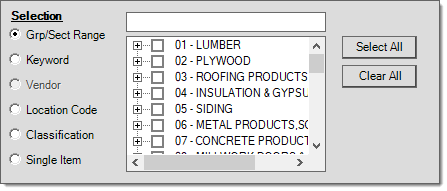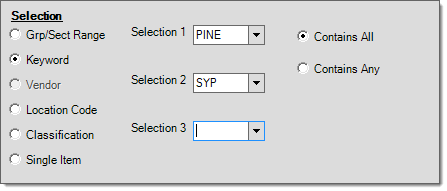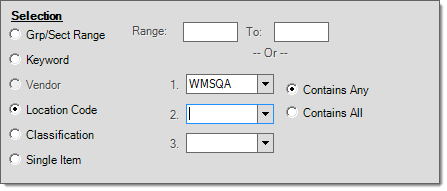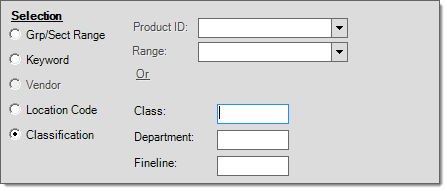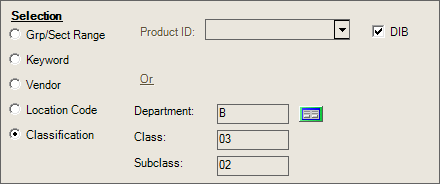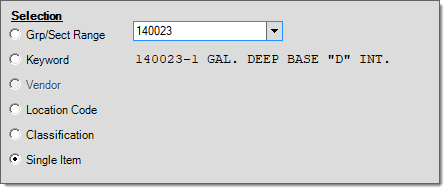Price Updates - Sale Item Setup
The "Sale Item Setup" option is used to set up a temporary change in price for a date period you specify. For a new sale, specify the starting and ending dates for the sale period, promotional ID (optional), and then either manually enter or Import (F2) sale items into the grid. To modify an existing sale (that has not yet been applied), choose the same dates as the original sale or select the sale using the "Promo ID" drop down.
Price Updates: Sale Item Setup
When a date range is specified or a promo ID selected that corresponds with an existing sale, the prompt "Copy in existing sale price data?" appears. Choosing "no" does not remove existing unapplied sale pricing; however, if you don't copy in existing sale pricing and re-enter an item that does have an unapplied sale price for the same period, it will be replaced should you Process (F12) the Price Update. If you answer "yes" to the prompt, all items with unapplied sale pricing matching the period or promo ID are copied into the grid with the current unapplied sale price listed under the "New Sale" column.
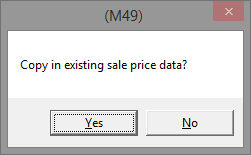
For unapplied sales, period dates are listed for each sale in the Apply Price/Sale Updates utility form. You can also use the Promo ID drop down to view the date ranges of all existing unapplied sales.
Starting Date
Use the calendar to set the beginning date for the sale period. Starting dates for previously saved, but unapplied, sale pricing are indicated by bold day numbers as shown in the calendar control.
Ending Date
This control allows you to set the ending date for the sale period.
Promo ID
This drop down control lists all unapplied sale pricing even when no promotional ID has been linked to the sale. This can be used as an alternative to date selection. Sale pricing updated as a result of EDI processing may be automatically linked to a promotional ID that is determined by your wholesaler. A user can also manually set their own "promo ID" by typing a value in the text area (a warning is provided if there's no matching promo; however, the ID will be saved with the sale items when the user chooses Process (F12)). Sale pricing is not available with all EDI options.
Should a user enter any items before choosing a Promo ID from the drop down control, a warning prompt is provided anytime the current starting sale date does not match the starting date of the selected promotion. When the starting dates do match, differences between the ending date of the promotion and selected ending date are not considered. In this case, the promotion items are appended to the data grid automatically. Existing items are retained, and any resulting duplicate items are neither merged nor removed automatically.
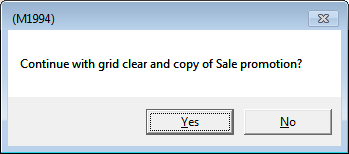
If the user responds "Yes" to the prompt, all entered items will be cleared (removed) and replaced by the selected promotion.
If the user responds "No" to the prompt, the promotion is not selected and no changes to the existing items or date selections will occur.
Sale prices must be entered corresponding to the unit of measure (U/M) displayed. Units of measure can be modified.
Sale prices can be modified or the entire unapplied sale can be deleted using the menu marker to the right of the ending date drop down.
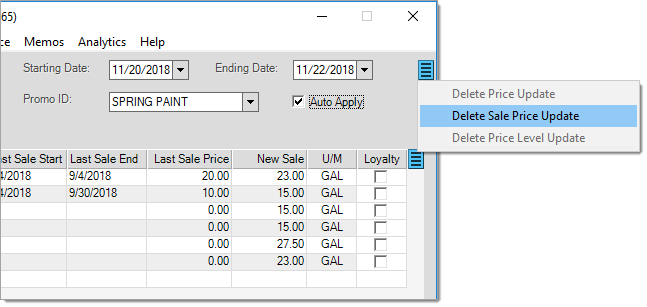
When an item has applied sale pricing history, the most recent applied sale information displays for reference. The columns "Last Sale Start," "Last Sale End," and "Last Sale Price" display the sale information from the most recent applied sale only.* The Folders (F4) can also be used to view information about each item you enter or select.

*The "most recent" sale is the top sale ordered by ending date of any applied sales for the item when either the starting or the ending date is prior to the current date. Sales are sorted by ending date in descending order, so the sale with the highest ending date is used for the "last sale" information. Future sales, meaning sale pricing that has not yet been applied or is not in effect yet, would not be considered.
The Import (F2) function can be used to copy items into the grid from an existing document or type (purchase order, previous sale, etc.).
Loyalty
Tiered pricing is available through Inventory > Price Updates, using the Sale Item Setup option. The same item can be entered in a single sale pricing instance if the dates for each are identical.
The example below shows two(2) similar items with a different price. The difference between the two items is that the Loyalty checkbox is selected for one of the items. In this scenario, a customer with no loyalty card will be charged $8.99 while the customer with the loyalty card will have the discounted price of $7.99.

Calculating Sale Prices
Sale pricing can be entered by hand; however, we provide a menu marker that offers a quick way to discount items using either the suggested list price or store retail. Before using this feature, please read and consider the following points:
•Discount functions do not discount prices based on amounts previously entered into the grid.
•Discount functions reprice all items entered in the grid at the time the function is chosen, not just the current item.
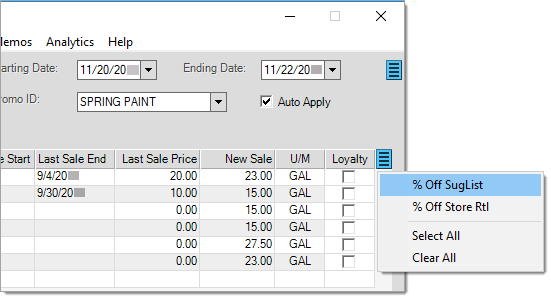
After a discount function is selected, the user receives prompt to enter a percentage. For a 5% discount, the user would enter 5 (not .05), for example. Decimal (partial) percentages are allowed. For example, entering 1.5 would result in a 1-1/2% discount.

After clicking the OK button, the user is asked whether or not each item's price rounding should be used. Price rounding determines the method used to round an item's price during Point of Sale transactions. For example, an item might always round to the nearest 9nth (.09) cent or penny. Price rounding is item specific and not mandatory.
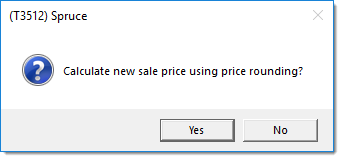
Once all items have been entered, choose Process (F12) to save your changes. A message appears asking users if they want to print a session report. Users should be aware that these reports are not retained as documents, so they are not available for reprint later (without re-saving the pricing update before it is applied). After the session report message, users are asked to select one or more branches.
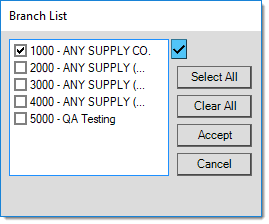
Branch List
If a mistake in sale pricing is made, it can be corrected by re-entering the same sale period for the item and changing the price either to the correct sale price or to the item's normal retail (if no sale price should be used). If the sale pricing has already been applied, use the "delete applied sale" option in this screen instead. Deleting the applied sale removes the sale for all items.
Import (F2)
The Price Updates options offer a variety of Import (F2) options. Due to the number of Price Update options, Import may only apply in certain circumstances and certain conditions are applied to items prior to import.
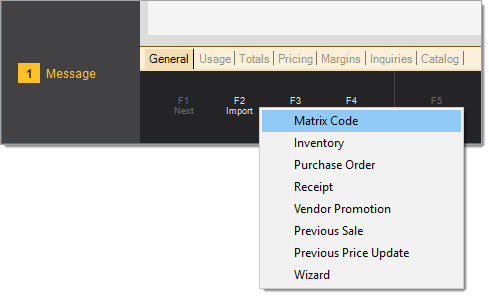
Price Update: Import (F2) Options
Conditions Applied Before Import
The following list of conditions are applied when items are imported:
•All Import (F2) options except the Wizard exclude "pull-to-length" tally items which are linked to other items. Other tally item types are not specifically excluded; however, not all are necessarily supported.
•When using the Level Maintenance option, items selected for import are checked to see if any of the item's price levels involve a type "P" (set price). If so, the item is copied (imported); otherwise, if no price levels involve a specifically set price (P), the item is notcopied.
Import Availability by Price Update Type
In the table shown below, the import types are listed along the top row (horizontally) and the types of price updates are listed in the first (left-most) column. For example, the "Matrix Code" Import (F2) option is only provided when using a "Price Cost Entry" or "Sale Item Setup" update type, and not provided with any of the other options.
|
|
Matrix Code |
Inventory |
Purchase Order |
Receipt |
Vendor Promotion |
Previous Sale |
Previous Price Update |
Wizard |
|---|---|---|---|---|---|---|---|---|
|
Price Cost Entry |
Yes |
Yes |
Yes |
Yes |
Yes |
Yes |
Yes |
Yes |
|
Branch Entry |
No |
Yes |
Yes |
Yes |
Yes |
Yes |
Yes |
No |
|
Sale Item Setup |
Yes |
Yes |
Yes |
Yes |
Yes |
Yes |
Yes |
No |
|
Level Maintenance |
No |
Yes |
Yes |
Yes |
Yes |
Yes |
Yes |
Yes |
|
Price Level Entry |
No |
Yes |
Yes |
Yes |
Yes |
Yes |
Yes |
Yes |
|
File Maintenance |
No |
Yes |
Yes |
Yes |
Yes |
Yes |
Yes |
Yes |
|
Cost/Margin Entry |
No |
No |
No |
No |
No |
No |
No |
No |
|
Delete Posted Sale |
No |
No |
No |
No |
No |
No |
No |
No |
|
Promotions Setup |
No |
No |
No |
No |
No |
No |
No |
No |
|
ACE Rewards |
No |
No |
No |
No |
No |
No |
No |
No |
Matrix Code
This option imports inventory items matching a price matrix code you specify. Matrix codes may be defined from either the Code Definitions form or from Item Maintenance and the Branch, Codes tab Price Matrix maintenance icon ![]() . When a matrix code is assigned to an item, pricing is calculated using defined multipliers and the specified basis price or cost. Multipliers less than 1.0 reduce the basis and multipliers greater than 1.0 increase the basis. Typically a number less than 1.0 would be used to provide a discount from the basis (which in this case would typically be either suggested list or store retail (level 0)). Numbers greater than 1.0 would usually be used with a basis that represents one of the item's costs (market, last receipt, or average cost) to calculate a price that is higher than the cost.
. When a matrix code is assigned to an item, pricing is calculated using defined multipliers and the specified basis price or cost. Multipliers less than 1.0 reduce the basis and multipliers greater than 1.0 increase the basis. Typically a number less than 1.0 would be used to provide a discount from the basis (which in this case would typically be either suggested list or store retail (level 0)). Numbers greater than 1.0 would usually be used with a basis that represents one of the item's costs (market, last receipt, or average cost) to calculate a price that is higher than the cost.
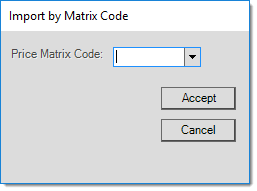
Import (F2), Matrix Code
Only two (2) Price Update options support Import (F2) by Matrix code: Price Cost Entry and Sale Item Setup.
Inventory
The Import (F2) option for inventory offers a variety of options for selecting and copying inventory items into a transaction's data grid. Selection choices include the following: group/section range, keyword, location code, and classification.

Inventory Copy
The Selection control used here matches the control used by inventory reports and functions identically. For more detailed information about selection by inventory, ![]() click here
click here
Purchase Order
This option is used to copy items from an existing purchase order document. The item number, retail price (if any), and unit cost from the purchase order are copied. Unit Cost is converted to match the item's Pricing Unit of Measure if different. The retail price should already match the item's Pricing unit of measure unless it has been changed since the Purchase Order document was created. This Import (F2) option is available for most Price Update options excluding the following: Cost/Margin Entry, Delete Posted Sale, ACE Rewards, and Promotions Setup.
Receipt
This option is used to copy items from an existing inventory receipt document. Only items with a received quantity greater than zero are copied (imported). Only the item from the Inventory Receipt document is copied, not any pricing or cost information. Item costs are updated when inventory (items) are received. This Import (F2) option is available for most Price Update options excluding the following: Cost/Margin Entry, Delete Posted Sale, ACE Rewards, and Promotions Setup.
Vendor Promotion
Vendor promotions originate from a supplier and indicate special pricing for specific items for a specified period of time. This import option is only used with Do it Best® EDI currently. It does not refer to ACE Rewards™ or "promotions" which aren't traditional sale pricing and are applied with additional criteria.
The vendor's promotional data is compared to your inventory's vendor-item data to locate matching items. Pricing may be adjusted from the vendor's price if your corresponding item has a matching vendor-item with a package quantity defined. Package quantity is not considered if the "disable package conversion" is set on the vendor-item or the unit of measure already matches the default UM for Price Updates and the package quantity is one. If package conversion is not disabled, the package quantity is converted to the base unit of measure (based on the package quantity's designated unit of measure). This figure may be used to adjust the price if the resulting quantity isn't a one-to-one relationship with the vendor's package quantity. Costs, when applicable, are not adjusted and typically would not be found in promotional data.
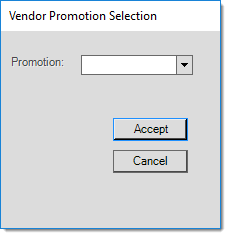
The promotion ID, promo description, and vendor code are listed for selection.
|
Important! Since your vendor's units of measure may not match with the measures your company uses for pricing, you should always visually compare prices to their associated units of measure to make sure they make sense before processing any changes. |
When this option is used along with the Sale Pricing option, starting and ending sale dates are set to match the vendor's promotion by default.
Items must be marked for "copy" using the EDI Promotions utility prior to import. Only selected "copy" items are imported.
This Import (F2) option is usually used with the Sale Pricing option; however, it is available for most Price Update options excluding the following: Cost/Margin Entry, Delete Posted Sale, ACE Rewards, and Promotions Setup.
Previous Sale
This option allows you to copy items from a previously applied "sale" price update. Sale Price updates are selected by document, not dates. After selecting a sale document, a dialog is shown asking whether you want to set the "new" price to match the most recent sale price for the items being copied (imported). The most recent sale price is not necessarily the same as the price from the document you select. If you select "no," only the items and their current pricing are copied (imported) into the data grid.

|
Warning! If you respond "Yes" to the prompt, the price is set to match the most recent sale price for the item even if the Price Update selection is not Sale Pricing! |
This Import (F2) option is usually used with the Sale Pricing option; however, it is available for most Price Update options excluding the following: Cost/Margin Entry, Delete Posted Sale, ACE Rewards, and Promotions Setup.
Previous Price Update
The "previous price update" option allows you to copy items from a previously applied price update (does not include "sale" pricing which are maintained separately). No conditions are applied to the data and only the list of items from the document is copied (imported). Pricing from the document is not imported.
Import Wizard
The Import (F2), Wizard option provides a generic way to import external data into the application. There are two methods for data selection: document and Windows file. The document option allows you to select any document. The "Windows File" option can be used to import data from a delimited file or spreadsheet, for example. Different transactions have different requirements. As one example, the wizard may be used for copying inventory items into a transaction's data grid. In this case, copying inventory items is only possible if the source document or data selected contains item information.
To import data using the Wizard:
1. In the Tags & Labels Printing form, choose Import (F2). The Import Wizard dialog box displays.
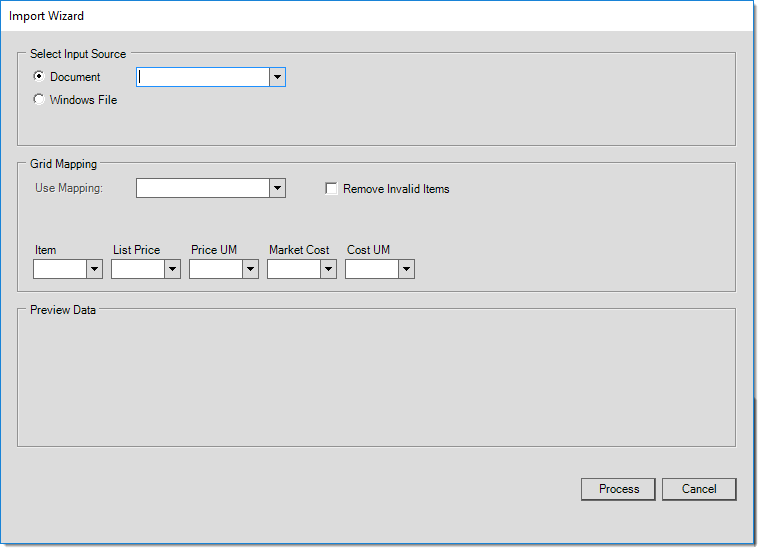
2. From the Document list, choose the Wizard file or document that contains the items you want to import from the context list.
3. Choose the kind of file you are importing the information from (Document or Windows file) and choose the name and location of the file from the list.
The Grid Mapping section changes based on the transaction and is used for determining which data columns (listed in the "Preview Data" panel) are to be used from the source (document or file). The source document or file will contain some columns that apply to the transaction specific "mapping" and some that don't. Mapping selections can be saved for future use. This is suggested if you repeatedly copy data from the same document type or file source.
4. Choose the Item, List Price, Price UM, Market Cost, and Cost UM locations in the original file from the drop-down lists to map the data you are importing correctly.
Note: Depending upon the type of information you are importing, these list options change. Additional conditions may be applied to the data after the user chooses Process. Choosing Cancel clears and closes the form without importing any data.
5. Select the Remove Invalid Items option, if applicable. (Not Required).
The Remove Invalid Items check box can be used to permit processing when one or more valid item rows are present in the data.
For example, if you have ten items and two of them have errors, check the Remove Invalid Items to produce a Task List with a Warning (and the option to Accept the warning) instead of a hard error. This would allow you to process the remaining the eight item rows without any errors.
5. Choose Process (F12)to complete the import wizard process.
Due to the mapping feature, the Wizard frequently can be used as a work around when other more specific Import functions are not provided.
The Import (F2) Wizard closes immediately after processing, so you'd want to "export" your errors before processing if you want to review and fix the items with errors later on. If you forget, you can always import the same file, export the errors and then cancel the import.
In the Price Updates transaction, and when enabled, the Wizard offers mapping fields that correspond with the selected Price Update option.
How Sale Pricing is Applied to Items
Sale pricing can be applied either automatically or manually. The "auto apply" check box can be used to apply sale pricing immediately to items (the pricing won't be given until the current date falls within the sale pricing range in this case). As an alternative, you can apply sale pricing later on by using the Apply Price/Sale Updates utility form (Main Menu > Inventory > Utilities > Updates > Apply Sale / Price Updates).
Items each maintain up to two (2) sale prices and periods at any given time. Applying additional sales to an item that already has two (2) applied sales replaces one of the existing sales. An item's applied sale prices can be viewed from Item Maintenance (or Inquiry: Branch / Pricing tab) as well as from the Folders (F4), Pricing tab.
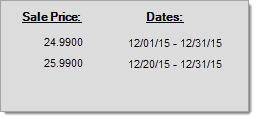
|
When sale pricing already exists for an item, how does the software decide which sale pricing to replace? Each item can have up to two (2) concurrent sale prices at any given time. If additional sales are applied to an item that already has at least one current sale price applied, a certain logic is applied to determine which sale price to update or replace. Here is how that logic is applied starting from top to bottom: If the new sale has the same starting and ending dates as the first sale price level (SaleCurrentPrice0), the first sale price will be replaced by the new sale price. Otherwise, if the new sale has the same starting and ending dates as the second sale price level (SaleCurrentPrice1), the second sale price will be replaced by the new sale price. Otherwise, if the new sale's end date is less than the first sale price level's end date -- or -- the first sale price level has no end date (means that the first sale price has not been set), the first sale price (if any) will be replaced by the new sale price. Otherwise, if none of the above conditions are met, the second sale price level is replaced by the new sale price. When an item has no sale pricing, the first sale price level is the one used. Current sale pricing for items is maintained in the InventoryStore database table. This table maintains the starting and ending dates for each of the two (2) sale levels. |
